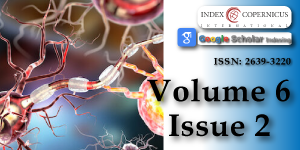Idiopathic progressive polyneuropathy presented with frequently acute pulmonary oedema: a case report
Main Article Content
Abstract
Neuropathy is when nerve damage interferes with the functioning of the peripheral nervous system (PNS). When the cause can’t be determined, it’s called idiopathic neuropathy(Idiopathic neuropathy, now designated as chronic idiopathic axonal polyneuropathy (CIAP).
There are three kinds of nerves within the PNS. Sensory nerves relay messages from the sense organs to the brain. This allows sensations of temperature and touch. Motor nerves transmit signals from the brain to the muscles. This helps the brain control the muscles. Autonomic nerves control body functions like heart rate, breathing, and digestion.
Damage to nerve cells can affect how the PNS communicates with the rest of the body. Symptoms can include numbness, pain, and balance issues.
It’s called acute neuropathy when symptoms develop suddenly. Alternately, it’s called chronic neuropathy when symptoms start slowly and increase over time. Diagnosis involves physical examination and review of medical history. Diagnostic testing may include blood tests, nerve testing, and imaging tests.
There is no cure for idiopathic neuropathy. Treatments including medication, physical therapy, and lifestyle modifications can help you function and feel better.
We report a case of idiopathic polyneuropathy presented with frequent acute pulmonary edema for a year.
Article Details
Copyright (c) 2022 Gultekin N

This work is licensed under a Creative Commons Attribution 4.0 International License.
Ware LB, Matthay MA. Clinical practice. Acute pulmonary edema. N Engl J Med. 2005 Dec 29;353(26):2788-96. doi: 10.1056/NEJMcp052699. PMID: 16382065.
O'Leary, R.; McKinlay, J. (2011). "Neurogenic pulmonary oedema". Continuing Education in Anaesthesia, Critical Care & Pain. 11 (3): 87–92. doi:10.1093/bjaceaccp/mkr006.
Givertz MM, Gottlieb SS, Finlay G. Noncardiogenic pulmonary edema. https://www.uptodate.com/contents/noncardiogenic-pulmonary-edema.Feb 6, 2018.
What is peripheral neuropathy. The Foundation for Peripheral Neuropathy. https://www.foundationforpn.org/what-is-peripheral-neuropathy/. Accessed April 2, 2016.
Rutkove SB. Overview of polyneuropathy. http://www.uptodate.com/home. Accessed April 2, 2016.
Vrancken AF, Franssen H, Wokke JH, Teunissen LL, Notermans NC. Chronic idiopathic axonal polyneuropathy and successful aging of the peripheral nervous system in elderly people. Arch Neurol. 2002 Apr;59(4):533-40. doi: 10.1001/archneur.59.4.533. PMID: 11939887.
Visser NA, Vrancken AF, van der Schouw YT, van den Berg LH, Notermans NC. Chronic idiopathic axonal polyneuropathy is associated with the metabolic syndrome. Diabetes Care. 2013 Apr;36(4):817-22. doi: 10.2337/dc12-0469. Epub 2012 Nov 30. PMID: 23204246; PMCID: PMC3609524.
Demirhan A, Yasar Tekelioglu U, Akkaya A, Dagistan E, Suzi Ayhan S, Ozturk S, Yildiz I, Kocoglu H. Magnetic resonance imaging contrast agent related pulmonary edema: a case report. Eur Rev Med Pharmacol Sci. 2012 Oct;16 Suppl 4:110-2. PMID: 23090824.
Sprooten RTM, Otte AAB, Cobben NAM, Steijns SCM, Rohde GGU, Wouters EFM. Orthopnea due to phrenic nerve involvement in neuralgic amyothrophy. European Respiratory Journal. 2014 44: P452.
Burton C, Chesterton LS, Davenport G. Diagnosing and managing carpal tunnel syndrome in primary care. Br J Gen Pract. 2014 May;64(622):262-3. doi: 10.3399/bjgp14X679903. PMID: 24771836; PMCID: PMC4001168.
Cahalin LP, Arena R, Guazzi M, Myers J, Cipriano G, Chiappa G, Lavie CJ, Forman DE. Inspiratory muscle training in heart disease and heart failure: a review of the literature with a focus on method of training and outcomes. Expert Rev Cardiovasc Ther. 2013 Feb;11(2):161-77. doi: 10.1586/erc.12.191. Erratum in: Expert Rev Cardiovasc Ther. 2013 Apr;11(4):520. PMID: 23405838; PMCID: PMC7304053.
Berbenetz N, Wang Y, Brown J, Godfrey C, Ahmad M, Vital FM, Lambiase P, Banerjee A, Bakhai A, Chong M. Non-invasive positive pressure ventilation (CPAP or bilevel NPPV) for cardiogenic pulmonary oedema. Cochrane Database Syst Rev. 2019 Apr 5;4(4):CD005351. doi: 10.1002/14651858.CD005351.pub4. PMID: 30950507; PMCID: PMC6449889.

